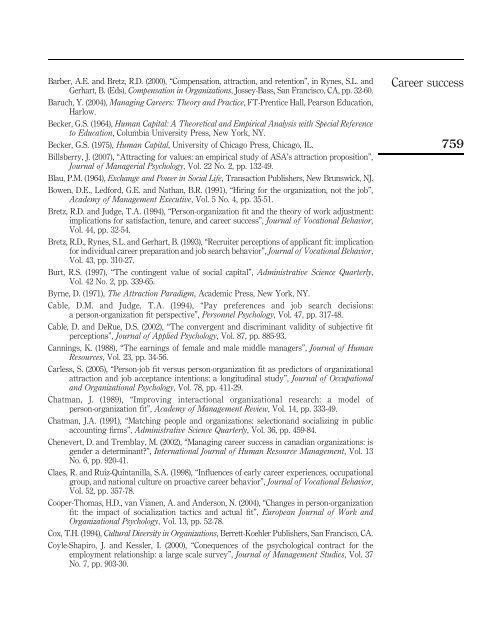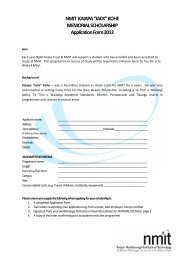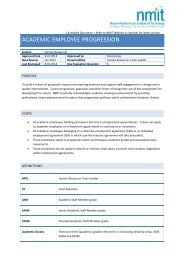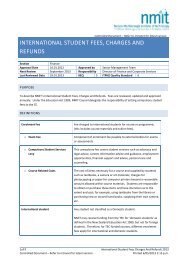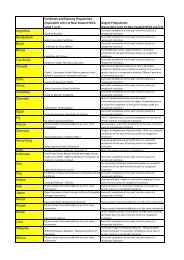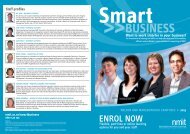JMP22,8758To conclude, career <strong>success</strong> has emerged as an important concern for both employeesand employers. This is due in large part to the demonstrated links between career<strong>success</strong> and a number of individual and organizational variables. Past research hastended to focus on sets of variables pertaining to the theory of rational choice andbehavior. <strong>Career</strong> <strong>success</strong> was assumed to be a function of human, motivational andorganization-specific variables that assessed the <strong>success</strong> an individual wishes to attain inhis or her career. The way we view career <strong>success</strong>, however, can be envisioned byinvestigating the influences of different types of PE fit on career <strong>success</strong>. It is widelyacknowledged that individuals and organizations are nowadays experiencing differentmodels of careers as compared to previous decades, and both have to share responsibilityin managing and controlling the process and the challenging nature of career <strong>success</strong>.Because careers are changing, and there is widespread agreement among researchersand practitioners that career <strong>success</strong> is no longer solely determined by a set ofwell-defined variables, the effects of different types of PE fit may provide insight intohow employees and employers can achieve a substantial fit in managing the process ofcareer advancement. As this article suggests, the influence of various forms of PE fit oncareer <strong>success</strong> may prove to be useful avenue for future careers research and mayprovide additional insights for researchers, employees, employers and counselors.ReferencesAckah, C. and Heaton, N. (2004), “The reality of ‘new’ careers for men and for women”, Journal ofEuropean Industrial Training, Vol. 28 Nos 2/3/4, pp. 141-58.Adkins, C.L., Russel, C.J. and Werbel, J.D. (1994), “Judgments of fit in the selection process:the role of work value congruence”, Personnel Psychology, Vol. 47, pp. 605-23.Agarwal, N. (1981), “Determinants of executive compensation”, Industrial Relations, Vol. 20,pp. 36-45.Allen, T., Eby, L., Poteel, M., Lentz, E. and Lima, L. (2004), “<strong>Career</strong> benefits associated withmentoring for proteges: a meta-analysis”, Journal of Applied Psychology, Vol.89No.1,pp. pp127-36.Alvesson, M. (2000), “Social identity and the problem of loyalty in knowledge-intensivecompanies”, Journal of Management Studies, Vol. 37 No. 8, pp. 1101-23.Alvesson, M. (2001), “Knowledge work: ambiguity, image and identity”, Human Relations, Vol. 54No. 7, pp. 863-86.Anackwe, U.P., Hall, J.C. and Schor, S. (2000), “Knowledge-related skills and effective careermanagement”, International Journal of Manpower, Vol. 21 No. 7, pp. 566-79.Arthur, M.B. (1994), “The boundaryless career: a new perspective for organizational inquiry”,Journal of Organizational Behavior, Vol. 15 No. 4, pp. 295-306.Arthur, M., Claman, P. and Defillipi, R. (1995), “Intelligent entreprise, intelligent career”,The Academy of Management Executive, Vol. 9 No. 4, pp. 7-22.Arthur, M.B., Khapova, S.N. and Wilderom, C.P.M. (2005), “<strong>Career</strong> <strong>success</strong> in a boundarylesscareer world”, Journal of Organizational Behavior, Vol. 26, pp. 177-202.Aryee, S., Chay, Y.W. and Tom, H.H. (1994), “An examination of the antecedents of subjectivecareer <strong>success</strong> among a managerial sample in Singapore”, Human Relations, Vol. 47 No. 5,pp. 487-509.Ashford, S. and Cummings, L.L. (1983), “Feedback as an individual resource: personal strategies ofcreating information”, Organizational Behavior and Human Performance, Vol. 32, pp. 370-98.
Barber, A.E. and Bretz, R.D. (2000), “Compensation, attraction, and retention”, in Rynes, S.L. andGerhart, B. (Eds), Compensation in Organizations, Jossey-Bass, San Francisco, CA, pp. 32-60.Baruch, Y. (2004), Managing <strong>Career</strong>s: Theory and Practice, FT-Prentice Hall, Pearson Education,Harlow.Becker, G.S. (1964), Human Capital: A Theoretical and Empirical Analysis with Special Referenceto Education, Columbia University Press, New York, NY.Becker, G.S. (1975), Human Capital, University of Chicago Press, Chicago, IL.Billsberry, J. (2007), “Attracting for values: an empirical study of ASA’s attraction proposition”,Journal of Managerial Psychology, Vol. 22 No. 2, pp. 132-49.Blau, P.M. (1964), Exchange and Power in Social Life, Transaction Publishers, New Brunswick, NJ.Bowen, D.E., Ledford, G.E. and Nathan, B.R. (1991), “Hiring for the organization, not the job”,Academy of Management Executive, Vol. 5 No. 4, pp. 35-51.Bretz, R.D. and Judge, T.A. (1994), “Person-organization fit and the theory of work adjustment:implications for satisfaction, tenure, and career <strong>success</strong>”, Journal of Vocational Behavior,Vol. 44, pp. 32-54.Bretz, R.D., Rynes, S.L. and Gerhart, B. (1993), “Recruiter perceptions of applicant fit: implicationfor individual career preparation and job search behavior”, Journal of Vocational Behavior,Vol. 43, pp. 310-27.Burt, R.S. (1997), “The contingent value of social capital”, Administrative Science Quarterly,Vol. 42 No. 2, pp. 339-65.Byrne, D. (1971), The Attraction Paradigm, Academic Press, New York, NY.Cable, D.M. and Judge, T.A. (1994), “Pay preferences and job search decisions:a person-organization fit perspective”, Personnel Psychology, Vol. 47, pp. 317-48.Cable, D. and DeRue, D.S. (2002), “The convergent and discriminant validity of subjective fitperceptions”, Journal of Applied Psychology, Vol. 87, pp. 885-93.Cannings, K. (1988), “The earnings of female and male middle managers”, Journal of HumanResources, Vol. 23, pp. 34-56.Carless, S. (2005), “Person-job fit versus person-organization fit as predictors of organizationalattraction and job acceptance intentions: a longitudinal study”, Journal of Occupationaland Organizational Psychology, Vol. 78, pp. 411-29.Chatman, J. (1989), “Improving interactional organizational research: a model ofperson-organization fit”, Academy of Management Review, Vol. 14, pp. 333-49.Chatman, J.A. (1991), “Matching people and organizations: selectionand socializing in publicaccounting firms”, Administrative Science Quarterly, Vol. 36, pp. 459-84.Chenevert, D. and Tremblay, M. (2002), “Managing career <strong>success</strong> in canadian organizations: isgender a determinant?”, International Journal of Human Resource Management, Vol. 13No. 6, pp. 920-41.Claes, R. and Ruiz-Quintanilla, S.A. (1998), “Influences of early career experiences, occupationalgroup, and national culture on proactive career behavior”, Journal of Vocational Behavior,Vol. 52, pp. 357-78.Cooper-Thomas, H.D., van Vianen, A. and Anderson, N. (2004), “Changes in person-organizationfit: the impact of socialization tactics and actual fit”, European Journal of Work andOrganizational Psychology, Vol. 13, pp. 52-78.Cox, T.H. (1994), Cultural Diversity in Organizations, Berrett-Koehler Publishers, San Francisco, CA.Coyle-Shapiro, J. and Kessler, I. (2000), “Conequences of the psychological contract for theemployment relationship: a large scale survey”, Journal of Management Studies, Vol. 37No. 7, pp. 903-30.<strong>Career</strong> <strong>success</strong>759
- Page 5: the contract is a contract with one
- Page 8: JMP22,8748Bauer, 2005). Werbel and
- Page 12 and 13: JMP22,8752supervisors) in their wor
- Page 14 and 15: JMP22,8754P4. PC fit is likely to b
- Page 16 and 17: JMP22,8756to investigate the effect
- Page 20 and 21: JMP22,8760Crant, J.M. (1995), “Th
- Page 22 and 23: JMP22,8762Lin, S. and Huang, Y. (20
- Page 24: JMP22,8764Seibert, S.E., Crant, J.M


